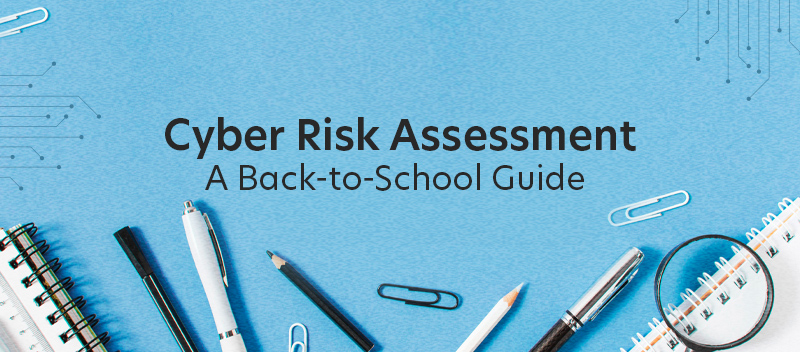Cyber Risk Assessment 101: A Back-to-School Guide

As the school year kicks off, students are not the only ones who have the chance to dive into fresh learning opportunities. This back-to-school season is a perfect time for businesses and individuals to brush up on something crucial — cybersecurity.
In a more connected world, understanding how to protect our digital spaces has become vital. Cyber risk assessment is your first line of defense, helping you spot potential threats and mitigate risks before they become problems.
This guide is designed to walk newcomers and seasoned tech enthusiasts through the essentials of cyber risk assessments, offering a solid foundation in this ever-important field.
The ABCs of Cyber Risk
Understanding the basics of cyber risk can feel like learning a new alphabet. Let’s break it down into simple terms.
A: Assets
Assets are the foundation of any organization and protecting them is critical. Here’s a closer look at what these assets encompass:
-
- Data: This includes everything from customer data, like contact information and transaction histories, to intellectual property, such as patents and proprietary algorithms.
- Systems: These are the backbone of operations, including physical servers, cloud services, and networking equipment — all critical for day-to-day functioning.
- Applications: These comprise software like CRM systems, financial applications, and communication tools, each integral to business processes.
By identifying these assets, you can prioritize your security measures and ensure the protection of your organization’s most valuable aspects.
B: Threats
Cyber threats constantly evolve and understanding them is crucial to developing an effective security strategy. Let’s dive into some common threats:
-
- Phishing Attacks: Malicious emails designed to trick individuals into revealing sensitive information.
- Malware: Ransomware and other malicious software can disrupt or gain unauthorized access to systems.
- Insider Threats: Employees or associates accessing your systems can maliciously or inadvertently harm the organization.
Understanding these threats allows you to build a defense strategy that protects your assets and mitigates risks.
C: Controls
Adequate controls are essential to mitigate these risks and protect assets. Here’s how some essential controls work:
-
- Firewalls: These act as a barrier to prevent unauthorized access.
- Access Controls: Limit access to sensitive information through role-based user permissions.
- Encryption: Protect sensitive information by encoding it, ensuring only authorized parties can access it.
- Multi-Factor Authentication (MFA): Adding an extra layer of security by requiring multiple forms of verification before granting access.
Together, these controls form the foundation of your cybersecurity strategy, helping you safeguard your digital environment.
For more on our Cybersecurity Risk Assessments services, Click Here
The Risk Assessment Process: A Step-by-Step Guide
The risk assessment process is your roadmap to understanding and mitigating cybersecurity threats. Following these simple steps can ensure a systematic approach to protecting your organization’s assets.
Step 1: Identify Assets
Review your organization’s critical assets, such as data, systems, and applications. Classify them based on their importance and sensitivity. Understanding what you have will help you prioritize your efforts.
Step 2: Threat Identification
Gather your team and brainstorm potential threats. Consider common scenarios like cyberattacks, natural disasters, or insider threats. You can also use tools like SWOT analysis to identify strengths, weaknesses, opportunities, and threats.
Step 3: Risk Analysis
Evaluate each identified threat by considering both likelihood and potential impact. A risk matrix helps visualize these factors, plotting risks based on their probability and severity. This visual can guide your understanding of which risks require immediate attention.
Step 4: Risk Prioritization
Once you’ve assessed your risks, prioritize them based on severity and likelihood. Focus on those with the most pressing risks, ensuring you protect your critical assets and allocate adequate resources.
Step 5: Risk Mitigation
Implement strategies to mitigate identified risks, including:
-
- Patching Vulnerabilities: Regularly update systems and software to address known vulnerabilities.
- Implementing Controls: Use firewalls, encryption, and multi-factor authentication to protect against unauthorized access.
Step 6: Continuous Monitoring
Cyber threats are constantly evolving. Regular monitoring allows you to adapt your strategies and defenses accordingly. Review and update your risk assessments to stay ahead of new vulnerabilities and threats.
Beyond the Basics: Resources and Support
Once you’ve mastered the basics, it’s time to explore more advanced techniques to elevate your strategies. Here’s how you can further your journey:
Kickstart with these beginner-friendly materials, which are perfect for building a solid foundation in cyber risk assessment.
— Check out our TrustNet blog posts and guides:
— Advanced Techniques
For those looking to move beyond the basics, delve into advanced methodologies such as:
-
- Quantitative Risk Analysis: Using statistical models to predict risk.
- Scenario Analysis: Simulate potential cyberattack scenarios to test your organization’s defenses.
- Threat Intelligence Integration: Incorporating real-time threat data into risk assessments.
— TrustNet’s Expertise: Your Partner in Cyber Risk Assessments
Partnering with a trusted cybersecurity provider like TrustNet ensures your organization is prepared to handle cyber threats effectively. Here’s how we can help.
- Comprehensive Risk Assessments: We conduct thorough evaluations to ensure that all aspects of Information Security — confidentiality, integrity, and availability — are upheld, providing a robust defense against potential threats.
- Clear Roadmap for Management: Our assessments result in a detailed, actionable roadmap that identifies potential security gaps, equipping management with the insights to make informed decisions.
- Technical Recommendations: TrustNet delivers precise, technical recommendations tailored to your unique context to strengthen your organization’s defenses and mitigate identified risks.
- Ongoing Support: Beyond initial assessments, TrustNet offers continuous support, monitoring, and updates to adapt to changing cybersecurity landscapes, ensuring enduring protection and resilience.
- Guidance for All Stages: Whether you’re beginning your cyber risk management journey or refining an existing strategy, TrustNet provides expert advice and resources to navigate complex challenges.
- Adaptation to Evolving Threats: We keep pace with the dynamic nature of cyber threats, constantly updating our strategies and tools to safeguard your assets in an ever-evolving digital world.
Ready to Strengthen Your Cybersecurity?
As explored throughout this guide, regular cyber risk assessments are crucial in safeguarding your organization’s digital assets and ensuring critical information’s confidentiality, integrity, and availability. These assessments provide a strategic foundation for identifying vulnerabilities and fortifying defenses against ever-evolving threats.
Now is the time to act — explore TrustNet’s wealth of resources and expert guidance tailored to your unique needs. By proactively addressing potential risks, you empower your organization with the resilience to navigate the digital landscape confidently, providing peace of mind for whatever challenges come your way.
Learn Cyber Risk Basics with TrustNet Experts. Contact us today.




